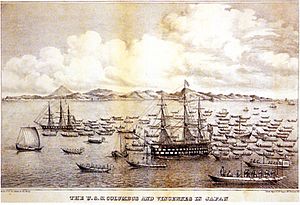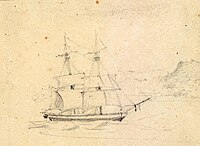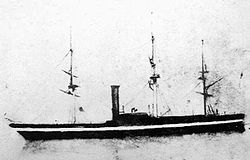East India Squadron
This articleneeds additional citations forverification.(June 2009) |
| East India Squadron | |
|---|---|
 | |
| Active | 1835–1868 |
| Country | |
| Branch | |
| Type | Naval squadron |
TheEast India Squadron,orEast Indies Squadron,was a squadron of American ships that existed in the nineteenth century. It focused on protecting American interests in theFar East,while thePacific Squadronconcentrated on the western coasts of theAmericasand theSouth Pacific Ocean.Its duties included theYangtze River Patrolin China. The East India Squadron was established in 1835 and existed until it became part of theAsiatic Squadronin 1868.
History[edit]

Shortly before SenatorLevi Woodburyof New Hampshire becamesecretary of the Navyin 1831,Edmund Robertshad sent him a letter detailing the neglected state of Far Eastern commerce andwhaling.Near the end of that year, Americanpepper traderFriendshipreturned to her home port ofSalem,to report that Sumatran pirates had killed thefirst officerand two crewmen, and plundered the cargo. In response to public outcry, PresidentAndrew Jacksondispatched thePotomacon the first of what were to be two punitive expeditions to Sumatra. Thesloop-of-warPeacockwas also dispatched, and, on the recommendation of Woodbury, carried Roberts as envoy toCochin-China,SiamandMuscat,to negotiate treaties to place American commerce on a surer basis, and on an equality with that of themost favored nations.[1]Roberts succeeded with Siamand Muscat.Peacockreturned in 1835–37 with Dr. W. S. W. Ruschenberger bearing ratifications of those treaties.[2]Peacock,which in 1828 had been broken down and rebuilt as an exploration vessel, joined theUnited States Exploring Expeditionin 1838. East India SquadronColumbiaandJohn Adamshad also joined thecircumnavigatingExpedition, and, without having to detour, executed the Second Sumatran Expedition.
Formation[edit]
Except for whaling and pepper, U.S. trade with the Far East was limited, but for those who risked long voyage to trade fur, sandalwood, and cotton goods for Chinese silks and tea, the results were very profitable. Indeed, stories about the riches of Far East created the national myth about the vast potential of the China market. In an effort to turn the myth into reality, the US sent envoy Roberts to Cochin-China in 1835 aboard thePeacock,escorted by theschoonerEnterpriseunder the command ofCommodoreEdmund P. Kennedy.They called first at the port ofCanton,and Roberts' account gives a vivid description of the state of affairs there.[1]: pp. 63–74 Kennedy subsequently established the East India Squadron.[3]
First Opium War[edit]
Several American citizens living in China suffered personal attacks during theFirst Opium Warfromxenophobiclocals. Commodore Kearny was given command of a squadron consisting of the 42-year-old frigateUSSConstellationand the sloopUSSBostonto protect American citizens in China. Kearny arrived in China in March 1842, a few months before the end of the conflict. Kearny first learned of theTreaty of Nankingwhen he arrived inHong Kong.Kearny observed the treaty's provisions opening five Chinese ports to British trade, and sought equal trading opportunity for Americans merchants. TheViceroyofCantonoffered Kearny a treaty giving Americans equal treatment. Kearny did not have authority to sign such a treaty, but tactfully informed Ke agreement would be forthcoming as soon as authorized negotiators arrived. In 1844,Caleb Cushingreached China where theTreaty of Wanghiawas signed on 2 July[4]and ratified the next year in December 1845.[5]
Opening of Japan[edit]
On July 20, 1846, he anchored with the two warshipsUSSColumbusandUSSVincennesinUraga Channelat the mouth to Edo Bay in an attempt toopenup Japan to trade with the United States, but was ultimately unsuccessful. Biddle delivered his request that Japan agree to a similar treaty to that which he had just negotiated with China. Biddle eventually received the shogunate's response and was told that Japan forbade all commerce and communication with foreign nations besides that of the Dutch; also, he was informed that all foreign affairs were conducted throughNagasakiand that his ships should leave Uraga immediately.[6]
In 1852, CommodoreMatthew C. Perryembarked fromNorfolk, Virginiafor Japan, in command of a squadron in search of a Japanese trade treaty. Aboard a black-hulled steam frigate, he ported Mississippi, Plymouth, Saratoga, and USSSusquehanna atUraga HarbornearEdo(modernTokyo) on July 8, 1853. His actions at this crucial juncture were informed by a careful study of Japan's previous contacts with Western ships and what could be known about the Japanese hierarchical culture. He was met by representatives of theTokugawa Shogunatewho told him to proceed toNagasaki,where there was limited trade with the Netherlands and which was the only Japanese port open to foreigners at that time (seeSakoku).
Perry returned in February 1854 with twice as many ships, finding that the delegates had prepared a treaty embodying virtually all the demands in Fillmore's letter. Perry signed theConvention of Kanagawaon March 31, 1854, and departed, mistakenly believing the agreement had been made withimperialrepresentatives.[7]The agreement was made with the Shogun, the de facto ruler of Japan.
Johanna Expedition[edit]
TheJohanna Expeditionwas a naval operation that occurred in August 1851 during the Americananti-slavery patrolsin theIndian Ocean.It began in response the seizure of the merchant shipMariaand hercaptain,a man named Moores, in the smallSultanate of Johanna.The United States Navy sent the sloop-of-warUSSDale,under CaptainWilliam Pearson,to free Moores and to demand compensation for the incident. When thesultanrefused, the Americans briefly bombarded afortandblockhouseprotecting the harbor ofMatsamudu.[8][9]
Anti-piracy operations[edit]

In July 1855, Chinese pirates in theHong Kongarea captured four merchant ships owned by British subjects. In response, on 4 August 1855, armed boats from the East India Squadron frigateUSSPowhatanand theRoyal Navysloop-of-warHMSRattlerconfronted the pirates at theBattle of Ty-ho Bay.HMSEaglettowed the boats into position which then proceeded to destroy twenty of thirty-sixjunks.Seven merchant ships were also rescued. An estimated 500 pirates were killed or wounded and over 1,000 taken prisoner compared to an allied loss of nine dead and about a dozen wounded.
Second Opium War[edit]
The United States would see action again during theSecond Opium Warfrom 1856 to 1860. Four of the squadron's ships were involved in at least two battles. At the beginning of the war, the United States Navy frigate,USSSan Jacintoand twosloops-of-war,USSPortsmouthandUSSLevant,launched an attack against a series ofChinesefortsalongPearl River.The engagement became known as theBattle of the Pearl River Fortsand was fought in 1856. The second involvement of an East India Squadron ship was during theSecond Battle of Taku Fortsin 1859. The American warship,USSPowhatan,assisted anAnglo-Frenchattack by bombarding theTaku Forts.No further engagements between Chinese and American forces during the war are known to have happened though American citizens living inCantonfought asmilitiaat the 1856battleat Canton.

Bombardment of Qui Nhon[edit]
On June 30, 1861,USSSaginaw,underJames F. Schenck,silenced a fort at the entrance toQui Nhon Bay,Cochinchina.This was after aVietnameseartillery battery had fired upon her while she was searching for the missing boat and crew of an American merchant bark namedMyrtle.After an engagement lasting just under an hour, the Vietnamese fort was destroyed and a large explosion was observed by the Americans. It became the only battle of theCochinchina Campaigninvolving the United States which deployed the East India Squadron to protect American interests in the region.
Formosan Expedition[edit]
Following theRover Incidentof March 1867 in which the American barkRoverwas wrecked and massacred by thePaiwan peopleof southernFormosa;the East India Squadron under Rear AdmiralHenry H. Belllaunched apunitiveexpeditionin retaliation. On June 18, 1867, 181 officers, sailors and marines from two screw sloops-of-war landed with the intention of destroying the hostile threat. After six hours of marching through the hot tropical Formosan mountains and after several skirmishes, the Americans turned back to their ships. The expedition failed after the death of an American commander and the loss of several men due to thehumidclimate. They boardedUSSWyomingandUSSHartfordand then set sail for Shanghai. A year later the squadron was merged into the new Asiatic Squadron.
Ships[edit]
USSPowhatan,underCommanderWilliam J. McCluney,was assigned to the East India Squadron and arrived on station via Cape of Good Hope 15 June 1853. Her arrival in Chinese waters coincided with an important phase of CommodoreMatthew C. Perry'snegotiations for commercial relations with the Japanese and the opening of two ports. She was Perry's flagship during his November visit to Whampoa. On 14 February 1854 she enteredYedo Baywith the rest of the squadron and theTreaty of Kanagawawas signed on her deck on 31 March 1854.
Assigned to the East India Squadron under Commodore Matthew Perry, theUSSMacedonianwith Capt.Joel Abbotin command, was one of the six American ships arrayed off Uraga, Japan, 13 February 1854 during Perry's second visit to negotiate the opening of Japan to foreign trade.
After completing her trials, which she began in January 1851, the side-wheel steamerUSSSusquehannasailed on 8 June for the Far East to become flagship of the East India Squadron.
TheUSSDolphingot underway 6 May 1848 to join the East India Squadron, protecting American citizens in Asiatic waters.
Recommissioned on 12 August 1850,USSSaratogagot underway on 15 September and proceeded to the western Pacific for service in the East India Squadron.
USSLevantsailed 13 November for Rio de Janeiro, the Cape of Good Hope, and Hong Kong, where she arrived to join the East India Squadron 12 May 1856. On 1 July she embarked the U.S. Commissioner to China for transportation to Shanghai, arriving 1 August.
Departing Norfolk 4 August, theUSSGermantownsailed via the Cape of Good Hope to Ceylon, where on 22 December she joined Flag Officer Josiah Tattnall's East India Squadron off Point de Gala. For 2 years she cruised Far Eastern waters and visited the principal ports of China and Japan, where she found "uniform friendly reception" as the squadron guarded American interests in the Orient. Sailing via the Cape of Good Hope, she returned to Norfolk in April 1860
After a four-day stop at Singapore, where Commodore Armstrong relieved Commodore Joel Abbot in command of the East India Squadron, the frigateUSSSan Jacintoreached the bar off the mouth of the Me Nam (later theChao Phraya) River.
The new side-wheel steamerUSSSaginawsailed from San Francisco Bay on 8 March 1860, headed for the western Pacific, and reached Shanghai, China, on 12 May. She then served in the East India Squadron, for the most part cruising along the Chinese coast to protect American citizens and to suppress pirates. She visited Japan in November but soon returned to Chinese waters. On 30 June 1861, she silenced a battery at the entrance toQui Nhon Bay,Cochin China,which had fired upon her while she was searching for the missing boat and crew of American bark,Myrtle.On 3 January 1862,Saginawwas decommissioned at Hong Kong. On 3 July 1862, she returned toMare Islandfor repairs.
Commanders[edit]
Successive Commanders-in-Chief of the East India Squadron were as follows.[10]
- Edmund P. Kennedy,3 March 1835 – 10 October 1837
- George C. Read,14 December 1837 – 13 June 1840
- Lawrence Kearny,4 February 1841 – 27 February 1843
- Foxhall A. Parker Sr.,27 February 1843 – 21 April 1845
- James Biddle,21 April 1845 – 6 March 1848
- William Shubrick,6 March 1848 – 13 May 1848
- David Geisinger,13 May 1848 – 1 February 1850
- Philip Voorhees,1 February 1850 – 30 January 1851
- John H. Aulick,31 May 1851 – 20 November 1852
- Matthew C. Perry,20 November 1852 – 6 September 1854
- Joel Abbot,6 September 1854 – 15 October 1855
- James Armstrong,15 October 1855 – 29 January 1858
- Josiah Tattnall III,29 January 1858 – 20 November 1859
- Cornelius Stribling,20 November 1859 – 23 July 1861
- Frederick K. Engle,23 July 1861 – 23 September 1862
- Cicero Price,23 September 1862 – 11 August 1865
- Henry H. Bell,11 August 1865 – 11 January 1868
Served in squadron[edit]
Also serving in the squadron at one time were:
- Thomas O. Selfridge
- John Pope
- Edward A. Terryserved in the sloopGermantown,attached to the East India Squadron, from 1857 to 1859.
- William M. Woodserved as fleet surgeon with the East India Squadron from 1856 to 1858
- Montgomery Sicard
- James Glynn
- Andrew Hull FootecommandedUSSPortsmouthon 20–21 November 1856. Foote led a landing party that seized the barrier forts at Canton, China, in reprisal for attacks on American ships.
References[edit]
- ^abRoberts, Edmund (1837) [1837]. "Introduction".Embassy to the Eastern courts of Cochin-China, Siam, and Muscat: in the U. S. sloop-of-war Peacock... during the years 1832-3-4(Digitized ed.). Harper & brothers. p.5.RetrievedMarch 29,2012.
I addressed a letter to the Hon. Levi Woodbury.
- ^Stephen B. Young (2003)."Book review"(Journal of the Siam Society, Volume 91).Two Yankee Diplomats In 1830s Siam by Edmund Roberts and W. S. W. Ruschenberger. Edited with an introduction by Michael Smithies.Orchid Press.RetrievedMarch 2,2012.
Also of some relevance for future Thai foreign policy are the various comments by Roberts and Ruschenberger as to how the Siamese seemed genuinely to like Americans and to prefer them over other Caucasian nations.
- ^The Naval Institute historical atlas of the U.S. Navy By Craig L. Symonds, William J. Clipson, PG 64.
- ^Hanks, Robert J., CAPT USN "Commodore Lawrence Kearny, the Diplomatic Seaman"United States Naval Institute ProceedingsNovember 1970 pp.70–72
- ^Sewall, John S. (1905).The Logbook of the Captain's Clerk: Adventures in the China Seas,p. xxxi.
- ^Sewall, pp. xxxiv–xxxv, xlix, lvi.
- ^Sewall, pp. 243–264.
- ^"The Bombardment of Johanna".The New York Times.4 February 1852.
- ^www.history.navy.milhttps://web.archive.org/web/20110510005840/http://www.history.navy.mil/special%20highlights/pirates/Suppression%20of%20Piracy%20on%20Johanna%20Island%2C%20August%201851%2C%20Amerman%2C%20USMC%20HD.pdf.Archived fromthe original(PDF)on 2011-05-10.
{{cite web}}:Missing or empty|title=(help) - ^Kemp Tolley, Yangtze Patrol: The U.S. Navy in China, pg 317
Further reading[edit]
- Long, David Foster (1988)."Chapter Nine".Gold braid and foreign relations: diplomatic activities of U.S. naval officers, 1798–1883.Annapolis: Naval Institute Press. pp.207ff.ISBN978-0-87021-228-4.LCCN87034879.
